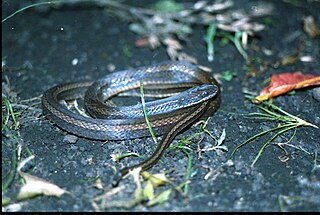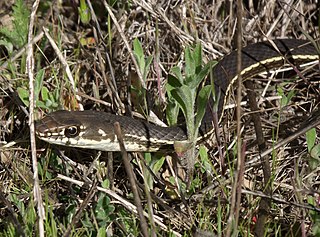
Micrurus is a genus of venomous coral snakes of the family Elapidae.

Aspidoscelis is a genus of whiptail lizards in the family Teiidae.

Masticophis flagellum is a species of nonvenomous colubrid snake, commonly referred to as the coachwhip or the whip snake, which is endemic to the United States and Mexico. Six subspecies are recognized, including the nominotypical subspecies.

Nerodia is a genus of nonvenomous colubrid snakes commonly referred to as water snakes due to their aquatic behavior. The genus includes nine species, all native to North America. Five of the species have recognized subspecies.

Salvadora is a genus of colubrid snakes commonly called patchnose snakes or patch-nosed snakes, which are endemic to the western United States and Mexico. They are characterized by having a distinctive scale on the tip of the snout.

Tantilla is a large genus of harmless New World snakes in the family Colubridae. The genus includes 66 species, which are commonly known as centipede snakes, black-headed snakes, and flathead snakes.

Coniophanes is a genus of colubrid snakes, commonly referred to as black-striped snakes, but they also have many other common names. The genus consists of 17 species, and despite the common name, not all of them display striping.

The Natricinae are a subfamily of colubroid snakes, sometimes referred to as a family (Natricidae). The subfamily comprises 36 genera. Members include many very common snake species, such as the European grass snakes, and the North American water snakes and garter snakes. Some Old World members of the subfamily are known as keelbacks, because their dorsal scales exhibit strong keeling.

The Colubrinae are a subfamily of the family Colubridae of snakes. It includes numerous genera, and although taxonomic sources often disagree on the exact number, The Reptile Database lists 717 species in 92 genera as of September 2019. It is the second largest subfamily of colubrids, after Dipsadinae. Many of the most commonly known snakes are members of this subfamily, including rat snakes, king snakes, milk snakes, vine snakes, and indigo snakes.

The California whipsnake, also known as the striped racer, is a colubrid snake found in habitats of the coast, desert, and foothills of California.

The striped whipsnake is a species of nonvenomous snake in the family Colubridae. It is closely related to the California whipsnake. The striped whipsnake is native to the western United States and adjacent northern Mexico.
Caryospora is a genus of parasitic protozoa in the phylum Apicomplexa. The species in this genus infect birds and reptiles with the majority of described species infecting snakes. It is the third largest genus in the family Eimeriidae.
Thamnosophis is a genus of pseudoxyrhophiid snakes found only on the island of Madagascar. As of 2014, six species were recognized.
Tretanorhinus is a genus of snakes in the subfamily Dipsadinae of the family Colubridae.
The Alameda whipsnake, also known as the Alameda striped racer, is a threatened subspecies of California whipsnake. It is a colubrid snake distinguishable by its broad head, large eyes, black and orange coloring with a yellow stripe down each side, and slender neck. The California whipsnake is found in California's northern and coastal chaparral. The Alameda whipsnake is a wary creature known for its speed and climbing abilities utilized when escaping predators or hunting prey. In winter months, the Alameda whipsnake hibernates in rock crevices and rodent burrows.

Masticophis schotti, commonly known as Schott's whip snake, is a species of snake in the family Colubridae.













